The Blood of Jesus: Mysterious and Majestic
here is nothing in the universe as potent, powerful, or personal as the precious blood of Jesus Christ. The Blood of Jesus has eternal value and infinite virtue. It is sinless and incorruptible. The blood of Christ is not a metaphor, but literal. The Bible testimony of Christ’s blood is clear and unequivocal. Blood is indeed a strange and mysterious substance, because scripture attests that ’life lies within the blood’ (Lev 17:11). Blood is consequently the unfathomable link between physical matter and spirit. How our soul interacts with this inexplicable substance is unclear, but we do know when God breathed into man, he became a ‘living soul’ (Gen 2:7).
The living component of our soul resides mostly in the blood. English physician, William Harvey who first discovered the circulation of the blood, said of it, “It is the first to live, and the last to die; and the primary seat of the soul. It lives and is nourished of itself and by no other part of the body.” By far and away, the most precious blood of all, is the blood of Christ, closely followed by the blood of innocents and martyrs (Gen 4:10, Mat 23:35).
The Blood line of Christ runs like a scarlet thread from Genesis to Revelation, revealing God’s plan of redemption. In order to commence His plan, God chose Abraham. This man, later became a family and finally, a nation. This nation would be temporarily trapped in Egypt for 400 years, but liberated by God’s supernatural providence. Through this nation (later Israel), chosen and set apart from others, God brought forth His oracles, on tablets of stone, and eventually, ‘a body prepared’ for the Lamb of God.
It’s time to decide…
When Jesus entered the earthly temple, declaring the Old Testament, Law and Prophets prophesied of His coming, His own blood would be the testifier (Lk 24:45-46). He would later enter the heavenly tabernacle, sprinkling His blood on the mercy seat, as testimony of His rightful title as savior of the universe. But, not everyone at the time, could envisage that His crucifixion and resurrection would eventually provide the key to unlock humanity from its spiritual slavery. In fact, many renowned prophets of the day either missed His coming entirely, or chose not to acknowledge the truth staring them in the face.
However, before you leave this earth, you too must decide whether Christ’s claim as savior of mankind was mere hubris or authentic. Have you considered what He did for you?
Have you considered what He did for you?
The importance of the blood sacrifice
Every Jew knew the significance of blood. The entire Old Testament religion was based on the concept of blood sacrifice. Without the shedding of blood there is no remission of sin (Heb 9:22) and without the ultimate sacrifice (Christ), the sin issue would still be unresolved. The biblical emphasis on the blood of atonement is referred to in no less than thirty-six bible verses. In fact, the blood of Jesus instituted the New Covenant and it is the very foundation of our faith.
The blood of Christ is indeed, the linchpin or bridge between the two testaments. It is by the shedding of His own blood, did Christ purge His people from sin. For indeed, Christ purchased the Church of God, with His blood (Acts 20:28).
Full and final atonement was provided at Calvary by the very words, ‘it is finished’ (Jn 19:30) and nothing should, nor needs to be added to Christ’s declaration.
Justified by His blood
We are justified by Christ’s blood and credited as being right with God because of it. Prior to Christ’s sacrifice, the wages of our sin were unpaid, solidifying our spiritual death sentence. We were all in a state of total hopelessness and depravity, had Christ not intervened as mediator between man and God.
We therefore conclude that the blood of Jesus satisfies God’s justice (Rom. 3:25–26), defeats Satan (See Rev. 12:11), and cleanses us from all sin (1 John 1:7). No wonder the Apostle Peter called Christ’s blood ‘precious’ (1 Pet. 1:19). Is it me or are we not hearing the blood of Jesus preached from pulpits, as much as we used to? Dr R T Williams had a famous saying when discipling young ministers, “honor the blood and honor the Holy Ghost.” If we allow liberal preachers or theologians, to back off from teaching about the atoning power of Christ’s blood then the devil will have won a major victory.
Take a look around you, we are living in a culture, where the blood of Christ is rarely preached anymore, having been replaced in the pulpit, by a ‘feel-good message,’ focusing on practical biblical principles for success, instead of the true gospel message of repentance and faith in the blood.
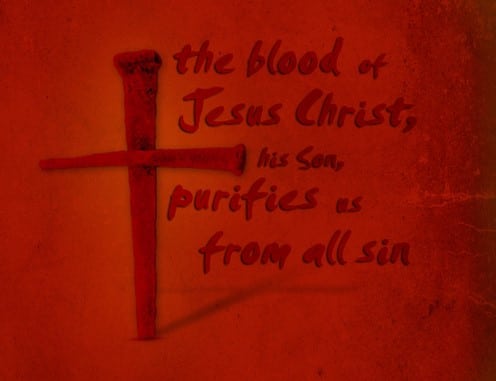
The Fourfold purpose of Christ’s Blood
We are redeemed, cleansed, justified, and reconciled by Christ’s blood. By it we enjoy access to God (Heb 10:19) and victory over Satan (Rev 12:11). The testimony of the redeemed-on earth exalts the blood of Christ (Rev. 1:5). The song of the redeemed in heaven does the same (Rev. 5:9).
The shedding of Christ’s blood is the defining moment of history and it will reside in the consciousness of the redeemed for all eternity.
Let us now review the most pertinent scriptures regarding the blood’s purpose:
- Redeemed – “In whom we have redemption through his blood, the forgiveness of sins, according to the riches of his grace” (Eph 1:17). “Forasmuch as ye know that ye were not redeemed with corruptible things, as silver and gold, from your vain conversation received by tradition from your fathers; But with the precious blood of Christ, as of a lamb without blemish and without spot.” (1st Pet 1:18-19)
- Cleansed – “But if we walk in the light, as he is in the light, we have fellowship one with another, and the blood of Jesus Christ his Son cleanseth us from all sin.” (1st Jn 1:7)
- Justified – “Much more then, being now justified by his blood, we shall be saved from wrath through him.“ (Rom 5:9)
- Reconciled – “And, having made peace through the blood of his cross, by him to reconcile all things unto himself; by him, I say, whether they be things in earth, or things in heaven.“ (Col 1:20)
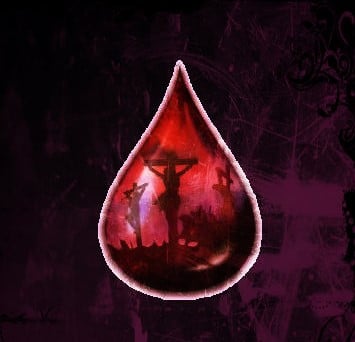 The average adult weighing 150 to 180 pounds should have about 1.2 to 1.5 gallons of blood in their body. This is about 4,500 to 5,700 mL., being approximately 7% of his entire body weight. The amount of blood in the human body can differ based on geographical location. For example, those who live in higher regions (like Colorado) have more blood and red corpuscles, because there isn’t as much oxygen at higher altitudes. The medical community cites four stages or classes of blood loss, with class IV being critical. A class IV loss represents about 40% of the total blood within the human body. It is difficult to ascertain the precise stages of blood loss Christ encountered along our road to redemption, albeit, stage IV was assuredly reached when he died on the cross.
The average adult weighing 150 to 180 pounds should have about 1.2 to 1.5 gallons of blood in their body. This is about 4,500 to 5,700 mL., being approximately 7% of his entire body weight. The amount of blood in the human body can differ based on geographical location. For example, those who live in higher regions (like Colorado) have more blood and red corpuscles, because there isn’t as much oxygen at higher altitudes. The medical community cites four stages or classes of blood loss, with class IV being critical. A class IV loss represents about 40% of the total blood within the human body. It is difficult to ascertain the precise stages of blood loss Christ encountered along our road to redemption, albeit, stage IV was assuredly reached when he died on the cross.
The Five-fold evidences of Christ’s blood being shed
The first evidence of Jesus shedding his blood was in the Garden of Gethsemane, ‘And being in anguish, he prayed more earnestly, and his sweat was like drops of blood falling to the ground’ (Luke 22:44). His struggle began in mental anguish, as he contemplated the sins of humanity being cast upon His soul, and the thought of eventually ‘becoming sin’ for us (2 Cor 5:21), which He later accomplished on the cross. Jesus began to sweat blood in the Garden of Gethsemane
Jesus began to sweat blood in the Garden of Gethsemane
The second time Jesus shed blood was after His flogging by Pilate’s order (Matt. 27:26. cf. John 19:1). The Passion movie, shows Christ’s horrific beating and scourging at the hands of merciless Roman guards by various weapons, including the cat and nine tails which tore flesh on the return stroke, utilizing sharp jagged pieces of iron at the end of each of the nine leather strands. Christ’s gruesome death began at the hands of Roman centurions who viciously mocked Him. Cat and Nine tails – A formidable weapon in the hands of an angry Roman Guard
Cat and Nine tails – A formidable weapon in the hands of an angry Roman Guard
The third would have followed the Roman soldiers’ having set a crown of thorns on his head (Matt. 27:29. cf. John 19:2). The objective of Pilate’s guards in doing this was to insult and inflict pain. The crown of thorns the soldiers forced on Jesus’ head may have been woven from the long spikelike thorns of the date palm, which are exceedingly sharp to the touch and can easily puncture thick plastics, to say nothing of flesh.
The crown of thorns has interesting symbolism for two reasons. It represented a crown of curses, as thorns and thistles, were formed as part of the curse on humanity (Gen 3:17-18). By wearing a crown of thorns, although the Romans meant it as a form of mockery, it was really Christ’s crown of suffering (Isa 53) and an allusion to His future role as conquering King (Rev 19). In actuality, Jesus wore the very crown which represented the curse which He would later become for us (Gal 3:13).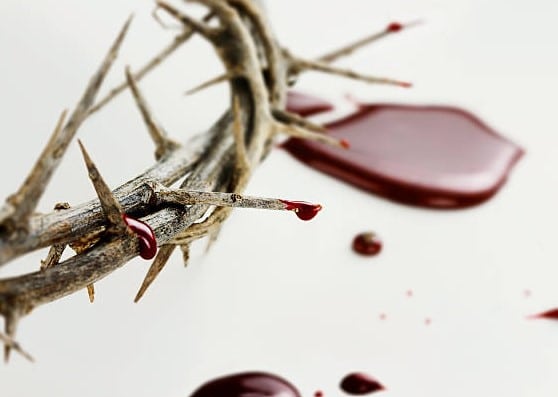 The Crown of Thorns – Symbolic of the curse He became for us (Gal 3:13)
The Crown of Thorns – Symbolic of the curse He became for us (Gal 3:13)
The fourth and main part of Jesus’ shedding of blood was the act of crucifixion itself. Crucifixion was indisputably one of the cruelest and most barbaric forms of punishment in the ancient world, having its origin in Persia. At the time Christ was crucified, this form of punishment was reserved exclusively for the most serious offenders, usually those who committed treasonous acts or participated in state terrorism. Christ was wrongly murdered in this manner, being an innocent man. Flavius Josephus described crucifixion as, ‘the most wretched of deaths.’ It was viewed in such horror that in one of Seneca’s letters to Lucilius, Seneca wrote that suicide was preferable to crucifixion.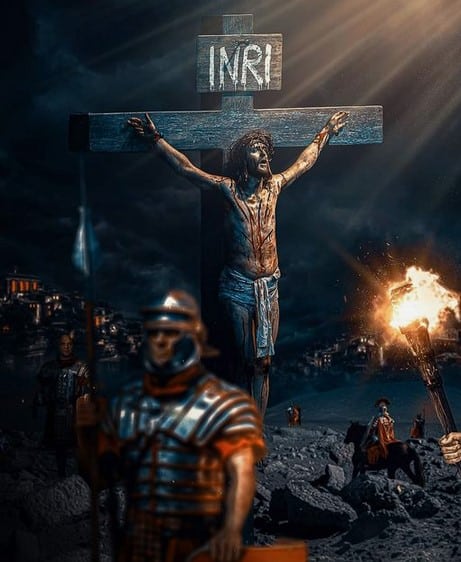 “It is Finished” – John 19:30
“It is Finished” – John 19:30
Nine-inch nails were thrust into Christ’s hands and feet into the wooden cross. This cross was then hoisted upwards and dropped into a hole in the ground. While hanging in extreme agony the blood dripped to the ground, flowing from Christ’s brow, his hands and feet—and possibly other parts of his body from the flogging. At this juncture, Christ most likely came very close to losing at least 40% of His entire blood supply, as His life force began to ebb away.
Christ spent six hours on the cross, an apt duration for the redemption of mankind. Man was created on the 6th day and the number six is symbolic of the pinnacle of God’s creation for that reason (Gen 1:24-31, Rev 13:18).
Christ was hoisted at the 3rd hour, which was 9 o’clock in the morning Jewish time. It was at this very moment the Lambs at the temple grounds were being prepared for sacrifice. By 3 o’clock that afternoon, when the people were singing praises to God, echoing throughout the hills of Jerusalem, as they watched the sacrificial lambs being slaughtered, it was at this very moment, Jesus died as ‘the’ Lamb of God, the once and for all sacrifice (Heb 10:1-18). Just as the animals were killed on the north side of the Altar at the temple, Jesus, too was crucified on the north side of Jerusalem. God is very precise in His prophetic fulfillment.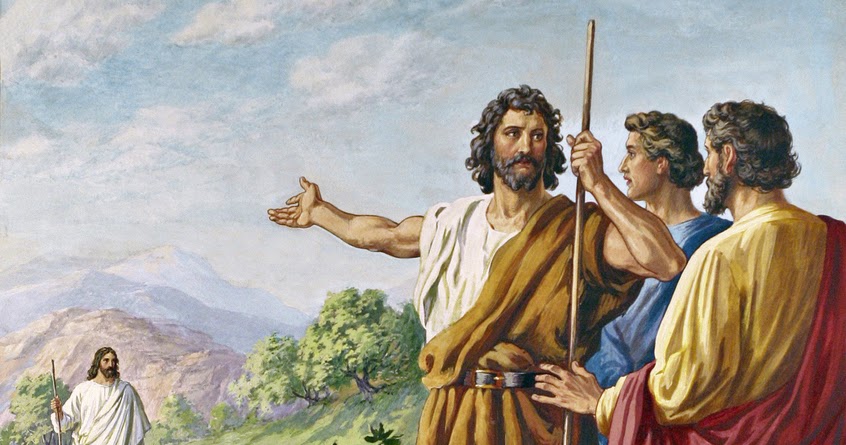 John the Baptist’s proclamation of Christ as the Lamb of God was fulfilled in every detail (John 1:29).
John the Baptist’s proclamation of Christ as the Lamb of God was fulfilled in every detail (John 1:29).
The fifth evidence of shedding blood, immediately following this death, was when a soldier ‘pierced Jesus’ side with a spear, bringing a sudden flow of blood and water’ (John 19:34). Scripture reveals, the blood and water bore witness to His ultimate sacrifice (1st Jn 5:7-9), something modern bible versions often debase in their translations by omitting the Godhead all together, from verse seven.
Authorities have claimed that the flowing forth of blood and water is physiological evidence that Christ’s heart was ruptured, and His death would be almost instantaneous. William Hendriksen in New Testament Commentary, Exposition of the Gospel of John, quotes from an article in Calvin Forum written by a prominent physician in Grand Rapids, Michigan, Dr. Stuart Bergsma, to the effect that blood and water flowing from a spear wound could have only come from a ruptured heart. It was at this moment, Christ gave up the Ghost (Mat 27:50).
The Hyssop Bush: P
here is nothing in the universe as potent, powerful, or personal as the precious blood of Jesus Christ. The Blood of Jesus has eternal value and infinite virtue. It is sinless and incorruptible. The blood of Christ is not a metaphor, but literal. The Bible testimony of Christ’s blood is clear and unequivocal. Blood is indeed a strange and mysterious substance, because scripture attests that ’life lies within the blood’ (Lev 17:11). Blood is consequently the unfathomable link between physical matter and spirit. How our soul interacts with this inexplicable substance is unclear, but we do know when God breathed into man, he became a ‘living soul’ (Gen 2:7).
The living component of our soul resides mostly in the blood. English physician, William Harvey who first discovered the circulation of the blood, said of it, “It is the first to live, and the last to die; and the primary seat of the soul. It lives and is nourished of itself and by no other part of the body.” By far and away, the most precious blood of all, is the blood of Christ, closely followed by the blood of innocents and martyrs (Gen 4:10, Mat 23:35).
The Blood line of Christ runs like a scarlet thread from Genesis to Revelation, revealing God’s plan of redemption. In order to commence His plan, God chose Abraham. This man, later became a family and finally, a nation. This nation would be temporarily trapped in Egypt for 400 years, but liberated by God’s supernatural providence. Through this nation (later Israel), chosen and set apart from others, God brought forth His oracles, on tablets of stone, and eventually, ‘a body prepared’ for the Lamb of God.
It’s time to decide…
When Jesus entered the earthly temple, declaring the Old Testament, Law and Prophets prophesied of His coming, His own blood would be the testifier (Lk 24:45-46). He would later enter the heavenly tabernacle, sprinkling His blood on the mercy seat, as testimony of His rightful title as savior of the universe. But, not everyone at the time, could envisage that His crucifixion and resurrection would eventually provide the key to unlock humanity from its spiritual slavery. In fact, many renowned prophets of the day either missed His coming entirely, or chose not to acknowledge the truth staring them in the face.
However, before you leave this earth, you too must decide whether Christ’s claim as savior of mankind was mere hubris or authentic. Have you considered what He did for you?
Have you considered what He did for you?
The importance of the blood sacrifice
Every Jew knew the significance of blood. The entire Old Testament religion was based on the concept of blood sacrifice. Without the shedding of blood there is no remission of sin (Heb 9:22) and without the ultimate sacrifice (Christ), the sin issue would still be unresolved. The biblical emphasis on the blood of atonement is referred to in no less than thirty-six bible verses. In fact, the blood of Jesus instituted the New Covenant and it is the very foundation of our faith.
The blood of Christ is indeed, the linchpin or bridge between the two testaments. It is by the shedding of His own blood, did Christ purge His people from sin. For indeed, Christ purchased the Church of God, with His blood (Acts 20:28).
Full and final atonement was provided at Calvary by the very words, ‘it is finished’ (Jn 19:30) and nothing should, nor needs to be added to Christ’s declaration.
Justified by His blood
We are justified by Christ’s blood and credited as being right with God because of it. Prior to Christ’s sacrifice, the wages of our sin were unpaid, solidifying our spiritual death sentence. We were all in a state of total hopelessness and depravity, had Christ not intervened as mediator between man and God.
We therefore conclude that the blood of Jesus satisfies God’s justice (Rom. 3:25–26), defeats Satan (See Rev. 12:11), and cleanses us from all sin (1 John 1:7). No wonder the Apostle Peter called Christ’s blood ‘precious’ (1 Pet. 1:19). Is it me or are we not hearing the blood of Jesus preached from pulpits, as much as we used to? Dr R T Williams had a famous saying when discipling young ministers, “honor the blood and honor the Holy Ghost.” If we allow liberal preachers or theologians, to back off from teaching about the atoning power of Christ’s blood then the devil will have won a major victory.
Take a look around you, we are living in a culture, where the blood of Christ is rarely preached anymore, having been replaced in the pulpit, by a ‘feel-good message,’ focusing on practical biblical principles for success, instead of the true gospel message of repentance and faith in the blood.

The Fourfold purpose of Christ’s Blood
We are redeemed, cleansed, justified, and reconciled by Christ’s blood. By it we enjoy access to God (Heb 10:19) and victory over Satan (Rev 12:11). The testimony of the redeemed-on earth exalts the blood of Christ (Rev. 1:5). The song of the redeemed in heaven does the same (Rev. 5:9).
The shedding of Christ’s blood is the defining moment of history and it will reside in the consciousness of the redeemed for all eternity.
Let us now review the most pertinent scriptures regarding the blood’s purpose:
- Redeemed – “In whom we have redemption through his blood, the forgiveness of sins, according to the riches of his grace” (Eph 1:17). “Forasmuch as ye know that ye were not redeemed with corruptible things, as silver and gold, from your vain conversation received by tradition from your fathers; But with the precious blood of Christ, as of a lamb without blemish and without spot.” (1st Pet 1:18-19)
- Cleansed – “But if we walk in the light, as he is in the light, we have fellowship one with another, and the blood of Jesus Christ his Son cleanseth us from all sin.” (1st Jn 1:7)
- Justified – “Much more then, being now justified by his blood, we shall be saved from wrath through him.“ (Rom 5:9)
- Reconciled – “And, having made peace through the blood of his cross, by him to reconcile all things unto himself; by him, I say, whether they be things in earth, or things in heaven.“ (Col 1:20)
 The average adult weighing 150 to 180 pounds should have about 1.2 to 1.5 gallons of blood in their body. This is about 4,500 to 5,700 mL., being approximately 7% of his entire body weight. The amount of blood in the human body can differ based on geographical location. For example, those who live in higher regions (like Colorado) have more blood and red corpuscles, because there isn’t as much oxygen at higher altitudes. The medical community cites four stages or classes of blood loss, with class IV being critical. A class IV loss represents about 40% of the total blood within the human body. It is difficult to ascertain the precise stages of blood loss Christ encountered along our road to redemption, albeit, stage IV was assuredly reached when he died on the cross.
The average adult weighing 150 to 180 pounds should have about 1.2 to 1.5 gallons of blood in their body. This is about 4,500 to 5,700 mL., being approximately 7% of his entire body weight. The amount of blood in the human body can differ based on geographical location. For example, those who live in higher regions (like Colorado) have more blood and red corpuscles, because there isn’t as much oxygen at higher altitudes. The medical community cites four stages or classes of blood loss, with class IV being critical. A class IV loss represents about 40% of the total blood within the human body. It is difficult to ascertain the precise stages of blood loss Christ encountered along our road to redemption, albeit, stage IV was assuredly reached when he died on the cross.
The Five-fold evidences of Christ’s blood being shed
The first evidence of Jesus shedding his blood was in the Garden of Gethsemane, ‘And being in anguish, he prayed more earnestly, and his sweat was like drops of blood falling to the ground’ (Luke 22:44). His struggle began in mental anguish, as he contemplated the sins of humanity being cast upon His soul, and the thought of eventually ‘becoming sin’ for us (2 Cor 5:21), which He later accomplished on the cross. Jesus began to sweat blood in the Garden of Gethsemane
Jesus began to sweat blood in the Garden of Gethsemane
The second time Jesus shed blood was after His flogging by Pilate’s order (Matt. 27:26. cf. John 19:1). The Passion movie, shows Christ’s horrific beating and scourging at the hands of merciless Roman guards by various weapons, including the cat and nine tails which tore flesh on the return stroke, utilizing sharp jagged pieces of iron at the end of each of the nine leather strands. Christ’s gruesome death began at the hands of Roman centurions who viciously mocked Him. Cat and Nine tails – A formidable weapon in the hands of an angry Roman Guard
Cat and Nine tails – A formidable weapon in the hands of an angry Roman Guard
The third would have followed the Roman soldiers’ having set a crown of thorns on his head (Matt. 27:29. cf. John 19:2). The objective of Pilate’s guards in doing this was to insult and inflict pain. The crown of thorns the soldiers forced on Jesus’ head may have been woven from the long spikelike thorns of the date palm, which are exceedingly sharp to the touch and can easily puncture thick plastics, to say nothing of flesh.
The crown of thorns has interesting symbolism for two reasons. It represented a crown of curses, as thorns and thistles, were formed as part of the curse on humanity (Gen 3:17-18). By wearing a crown of thorns, although the Romans meant it as a form of mockery, it was really Christ’s crown of suffering (Isa 53) and an allusion to His future role as conquering King (Rev 19). In actuality, Jesus wore the very crown which represented the curse which He would later become for us (Gal 3:13). The Crown of Thorns – Symbolic of the curse He became for us (Gal 3:13)
The Crown of Thorns – Symbolic of the curse He became for us (Gal 3:13)
The fourth and main part of Jesus’ shedding of blood was the act of crucifixion itself. Crucifixion was indisputably one of the cruelest and most barbaric forms of punishment in the ancient world, having its origin in Persia. At the time Christ was crucified, this form of punishment was reserved exclusively for the most serious offenders, usually those who committed treasonous acts or participated in state terrorism. Christ was wrongly murdered in this manner, being an innocent man. Flavius Josephus described crucifixion as, ‘the most wretched of deaths.’ It was viewed in such horror that in one of Seneca’s letters to Lucilius, Seneca wrote that suicide was preferable to crucifixion. “It is Finished” – John 19:30
“It is Finished” – John 19:30
Nine-inch nails were thrust into Christ’s hands and feet into the wooden cross. This cross was then hoisted upwards and dropped into a hole in the ground. While hanging in extreme agony the blood dripped to the ground, flowing from Christ’s brow, his hands and feet—and possibly other parts of his body from the flogging. At this juncture, Christ most likely came very close to losing at least 40% of His entire blood supply, as His life force began to ebb away.
Christ spent six hours on the cross, an apt duration for the redemption of mankind. Man was created on the 6th day and the number six is symbolic of the pinnacle of God’s creation for that reason (Gen 1:24-31, Rev 13:18).
Christ was hoisted at the 3rd hour, which was 9 o’clock in the morning Jewish time. It was at this very moment the Lambs at the temple grounds were being prepared for sacrifice. By 3 o’clock that afternoon, when the people were singing praises to God, echoing throughout the hills of Jerusalem, as they watched the sacrificial lambs being slaughtered, it was at this very moment, Jesus died as ‘the’ Lamb of God, the once and for all sacrifice (Heb 10:1-18). Just as the animals were killed on the north side of the Altar at the temple, Jesus, too was crucified on the north side of Jerusalem. God is very precise in His prophetic fulfillment. John the Baptist’s proclamation of Christ as the Lamb of God was fulfilled in every detail (John 1:29).
John the Baptist’s proclamation of Christ as the Lamb of God was fulfilled in every detail (John 1:29).
The fifth evidence of shedding blood, immediately following this death, was when a soldier ‘pierced Jesus’ side with a spear, bringing a sudden flow of blood and water’ (John 19:34). Scripture reveals, the blood and water bore witness to His ultimate sacrifice (1st Jn 5:7-9), something modern bible versions often debase in their translations by omitting the Godhead all together, from verse seven.
Authorities have claimed that the flowing forth of blood and water is physiological evidence that Christ’s heart was ruptured, and His death would be almost instantaneous. William Hendriksen in New Testament Commentary, Exposition of the Gospel of John, quotes from an article in Calvin Forum written by a prominent physician in Grand Rapids, Michigan, Dr. Stuart Bergsma, to the effect that blood and water flowing from a spear wound could have only come from a ruptured heart. It was at this moment, Christ gave up the Ghost (Mat 27:50).








































